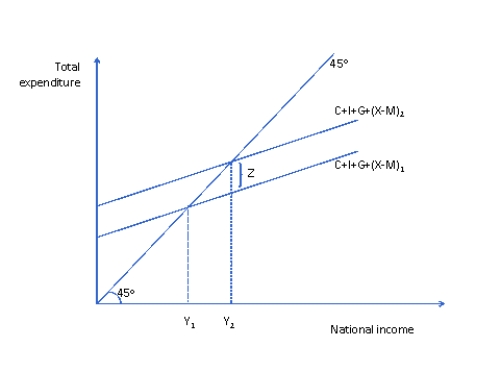Multiple Choice
Refer to Figure 1 below.If the vertical distance labelled Z represents a deflationary gap then which of the following statements is true? Figure 1
A) Y₂ represents the full employment level of output and total expenditure must be reduced from C+I+G+(X-M) ₂ to C+I+G+(X-M) ₁ in order to increase output and employment.
B) Y₁ represents the full employment level of output and total expenditure must be reduced from C+I+G+(X-M) ₂ to C+I+G+(X-M) ₁ in order to increase output and employment.
C) Y₂ represents the full employment level of output and total expenditure must be increased from C+I+G+(X-M) ₁ to C+I+G+(X-M) ₂ in order to increase output and employment.
D) Y₁ represents the full employment level of output and total expenditure must be increased from C+I+G+(X-M) ₁ to C+I+G+(X-M) ₂ in order to increase output and employment.
Correct Answer:

Verified
Correct Answer:
Verified
Q14: John Maynard Keynes' General Theory was an
Q25: Suppose that there are no crowding out
Q26: Figure 4<br> <img src="https://d2lvgg3v3hfg70.cloudfront.net/TB8816/.jpg" alt="Figure 4
Q32: Assume that the economy is in equilibrium
Q34: The multiplier model implies that<br>A) additional spending
Q36: What does the Keynesian cross diagram show?
Q43: What was John Maynard Keynes's primary message
Q48: In the IS-LM model, a rise in
Q54: Planned spending includes the intended or desired
Q55: Assume a central bank has been charged